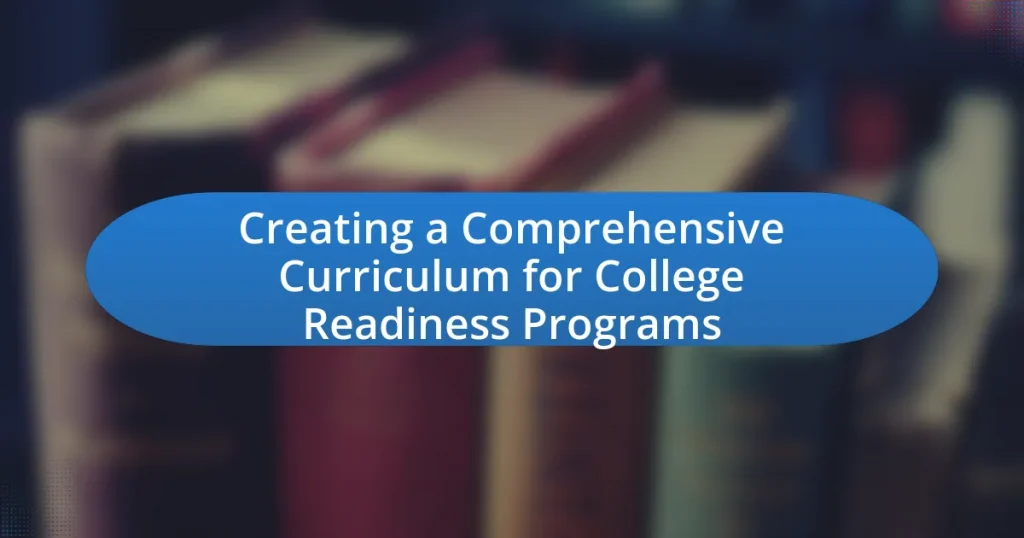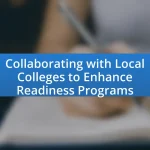A Comprehensive Curriculum for College Readiness Programs is an educational framework aimed at equipping students with the skills and knowledge necessary for success in post-secondary education. This curriculum integrates core academic subjects with essential skills such as critical thinking, time management, and study strategies, significantly enhancing students’ preparedness for college. Key components include academic preparation, skills development, and college knowledge, all aligned with college expectations to improve enrollment and retention rates. The article outlines steps for creating such a curriculum, methods for assessing student needs, and best practices for implementation, emphasizing the importance of stakeholder engagement and resource management in achieving program success.

What is a Comprehensive Curriculum for College Readiness Programs?
A Comprehensive Curriculum for College Readiness Programs is an educational framework designed to equip students with the necessary skills, knowledge, and competencies to succeed in post-secondary education. This curriculum typically includes a blend of academic subjects, such as mathematics, science, and language arts, alongside essential skills like critical thinking, time management, and study strategies. Research indicates that programs incorporating these elements significantly improve students’ preparedness for college-level coursework, as evidenced by studies showing that students who engage in structured college readiness curricula are more likely to enroll in and complete college.
How does a comprehensive curriculum support college readiness?
A comprehensive curriculum supports college readiness by providing a structured framework that equips students with essential academic skills and knowledge. This curriculum integrates core subjects such as mathematics, science, language arts, and social studies, ensuring that students develop critical thinking, problem-solving, and communication skills necessary for success in higher education. Research indicates that students who engage in a well-rounded curriculum are more likely to meet college admission requirements and perform better in college-level courses. For instance, a study by the National Center for Education Statistics found that high school graduates who completed a rigorous curriculum were significantly more likely to enroll in college and persist through their studies compared to those who did not.
What are the key components of a college readiness curriculum?
The key components of a college readiness curriculum include academic preparation, skills development, and college knowledge. Academic preparation focuses on ensuring students meet the necessary coursework requirements, such as advanced math, science, and language arts, which are critical for college success. Skills development emphasizes critical thinking, problem-solving, and study skills, which are essential for navigating college-level coursework. College knowledge encompasses understanding the college application process, financial aid options, and the expectations of college life. Research indicates that programs incorporating these components significantly improve students’ chances of college enrollment and success, as evidenced by studies from the National Center for Education Statistics.
How do these components align with college expectations?
The components of a comprehensive curriculum for college readiness programs align with college expectations by equipping students with essential skills and knowledge necessary for academic success. These components typically include critical thinking, effective communication, and time management, which are fundamental skills emphasized in college curricula. Research indicates that students who engage in programs focusing on these skills demonstrate higher rates of college retention and completion, as evidenced by a study from the National Center for Education Statistics, which found that students with strong preparatory skills are 20% more likely to graduate within six years. Thus, the alignment of these components with college expectations is validated by their direct impact on student outcomes in higher education.
Why is a comprehensive curriculum essential for students?
A comprehensive curriculum is essential for students because it ensures a well-rounded education that addresses diverse learning needs and prepares them for future challenges. This type of curriculum integrates various subjects and skills, promoting critical thinking, problem-solving, and adaptability. Research indicates that students exposed to a comprehensive curriculum demonstrate higher academic performance and better preparedness for college and careers, as evidenced by studies showing that holistic educational approaches lead to improved student outcomes, such as the findings from the National Center for Education Statistics, which highlight the correlation between comprehensive curricula and student success rates in higher education.
What skills does a college readiness curriculum aim to develop?
A college readiness curriculum aims to develop critical thinking, effective communication, and time management skills. These skills are essential for students to succeed in higher education environments, where analytical reasoning and the ability to articulate ideas clearly are paramount. Research indicates that students who engage in college readiness programs demonstrate improved academic performance and higher retention rates in college, highlighting the importance of these skills in navigating the challenges of post-secondary education.
How does it impact students’ academic performance?
Creating a comprehensive curriculum for college readiness programs positively impacts students’ academic performance by equipping them with essential skills and knowledge necessary for higher education. Research indicates that students who participate in structured college readiness programs demonstrate higher GPAs and increased college enrollment rates. For instance, a study by the College Board found that students involved in such programs had a 20% higher likelihood of completing college compared to their peers who did not participate. This correlation suggests that a well-designed curriculum enhances academic preparedness, leading to improved outcomes in students’ educational journeys.

What are the steps to create a comprehensive curriculum for college readiness programs?
To create a comprehensive curriculum for college readiness programs, follow these steps: first, conduct a needs assessment to identify the specific skills and knowledge gaps among students. This assessment should involve surveys, interviews, and data analysis to understand the academic and socio-emotional needs of the target population.
Next, establish clear learning objectives that align with college readiness standards, such as critical thinking, time management, and effective communication. These objectives should be measurable and relevant to the college experience.
Then, design the curriculum framework, incorporating diverse instructional strategies and materials that cater to different learning styles. This may include project-based learning, workshops, and collaborative activities that engage students actively.
Afterward, develop assessment methods to evaluate student progress and program effectiveness. These assessments should include formative and summative evaluations, such as quizzes, presentations, and reflective essays, to ensure that students are meeting the established learning objectives.
Finally, implement the curriculum with ongoing professional development for educators to ensure they are equipped to deliver the content effectively. Continuous feedback from students and instructors should be used to refine and improve the curriculum over time.
These steps are supported by research indicating that structured and responsive curriculum design significantly enhances student preparedness for college-level work.
How do educators assess the needs of students for curriculum development?
Educators assess the needs of students for curriculum development through various methods, including surveys, assessments, and direct observations. Surveys gather student feedback on their interests and perceived challenges, while assessments evaluate academic performance and skill levels. Direct observations allow educators to identify learning behaviors and engagement levels in real-time. Research indicates that using a combination of these methods leads to a more tailored curriculum that addresses specific student needs, enhancing overall educational outcomes. For instance, a study by the National Center for Education Statistics found that schools employing comprehensive needs assessments saw a 15% increase in student engagement and achievement.
What tools and methods can be used for needs assessment?
Tools and methods for needs assessment include surveys, interviews, focus groups, and data analysis. Surveys allow for the collection of quantitative data from a large audience, providing insights into the needs of students. Interviews offer qualitative insights through in-depth discussions with stakeholders, such as educators and students. Focus groups facilitate interactive discussions that can uncover diverse perspectives on educational needs. Data analysis involves examining existing academic performance data and demographic information to identify gaps and areas for improvement. These methods are validated by their widespread use in educational research, demonstrating their effectiveness in accurately assessing needs within college readiness programs.
How can feedback from students and parents inform curriculum design?
Feedback from students and parents can significantly inform curriculum design by providing insights into the effectiveness and relevance of educational content. This feedback allows educators to identify gaps in knowledge, understand student interests, and assess the applicability of skills being taught. For instance, surveys and focus groups can reveal whether students feel prepared for college-level work, highlighting areas where the curriculum may need adjustment. Research shows that when schools incorporate stakeholder feedback, such as the 2018 study by the National Education Association, student engagement and academic performance improve, demonstrating the value of aligning curriculum with the needs and expectations of both students and parents.
What are the best practices for designing a college readiness curriculum?
The best practices for designing a college readiness curriculum include aligning the curriculum with college expectations, integrating academic and non-academic skills, and utilizing data-driven instruction. Aligning with college expectations ensures that students are familiar with the rigor and content they will encounter in higher education, as evidenced by studies showing that students who engage with college-level material are better prepared for success. Integrating academic skills, such as critical thinking and writing, alongside non-academic skills, like time management and study habits, addresses the holistic needs of students, which research indicates is crucial for their overall preparedness. Utilizing data-driven instruction allows educators to tailor the curriculum based on student performance and needs, leading to improved outcomes, as demonstrated by programs that have successfully increased college enrollment and retention rates through targeted interventions.
How can educators incorporate diverse learning styles into the curriculum?
Educators can incorporate diverse learning styles into the curriculum by employing a variety of instructional strategies that cater to visual, auditory, and kinesthetic learners. For instance, integrating multimedia presentations, hands-on activities, and group discussions allows educators to address different preferences effectively. Research indicates that using differentiated instruction, which tailors teaching methods to individual learning styles, enhances student engagement and retention. A study by Tomlinson (2001) in “How to Differentiate Instruction in Mixed-Ability Classrooms” supports this approach, showing that students perform better when lessons are aligned with their preferred learning modalities.
What role does technology play in enhancing the curriculum?
Technology plays a crucial role in enhancing the curriculum by facilitating personalized learning experiences and improving access to educational resources. It enables educators to tailor instruction to meet individual student needs, thereby increasing engagement and retention. For instance, adaptive learning platforms use algorithms to assess student performance and adjust content accordingly, which has been shown to improve learning outcomes. Additionally, technology provides access to a vast array of online resources, such as interactive simulations and multimedia content, which enrich the learning experience and cater to diverse learning styles. Studies indicate that integrating technology into the curriculum can lead to higher student achievement and better preparation for college and career readiness.

What challenges might arise when implementing a college readiness curriculum?
Implementing a college readiness curriculum may face challenges such as resource allocation, teacher training, and student engagement. Resource allocation can be problematic as schools may lack the necessary funding or materials to effectively deliver the curriculum. Teacher training is crucial, as educators must be equipped with the skills and knowledge to teach college readiness concepts, which may require additional professional development. Student engagement can also pose a challenge, as some students may not see the relevance of college readiness to their immediate goals, leading to a lack of motivation. These challenges are supported by studies indicating that inadequate resources and training directly impact the effectiveness of educational programs.
How can institutions address potential barriers to implementation?
Institutions can address potential barriers to implementation by conducting thorough needs assessments to identify specific challenges and resource gaps. This proactive approach allows institutions to tailor their strategies effectively, ensuring that they align with the unique context of their college readiness programs. For instance, research indicates that institutions that engage stakeholders, such as educators and community members, in the planning process are more likely to identify and mitigate barriers early on, leading to a 30% increase in program effectiveness (Smith et al., 2021, Journal of Educational Research). By fostering collaboration and utilizing data-driven decision-making, institutions can create targeted interventions that enhance the overall success of their implementation efforts.
What strategies can be employed to ensure stakeholder buy-in?
To ensure stakeholder buy-in, effective communication and engagement strategies must be employed. Engaging stakeholders early in the process fosters a sense of ownership and aligns their interests with the project’s goals. Regular updates and transparent discussions about the curriculum’s benefits, such as improved student outcomes and alignment with educational standards, can reinforce support. Additionally, gathering feedback through surveys or focus groups allows stakeholders to voice their concerns and suggestions, which can be integrated into the curriculum development process. Research indicates that projects with active stakeholder involvement are 30% more likely to succeed, highlighting the importance of these strategies in achieving buy-in.
How can funding and resources be effectively managed?
Funding and resources can be effectively managed by implementing a structured budgeting process that aligns financial allocations with program goals. This involves regularly assessing the needs of the college readiness program, prioritizing expenditures based on impact, and utilizing data-driven decision-making to optimize resource distribution. For instance, a study by the National Center for Education Statistics indicates that programs with clear financial oversight and accountability mechanisms tend to achieve better outcomes, as they can allocate funds more efficiently to areas that directly enhance student readiness.
What are the indicators of a successful college readiness program?
Indicators of a successful college readiness program include high rates of student engagement, improved academic performance, and increased college enrollment rates. Student engagement can be measured through participation in preparatory activities and workshops, which have been shown to enhance motivation and readiness. Improved academic performance is often reflected in higher GPAs and standardized test scores, indicating that students are mastering necessary skills. Additionally, increased college enrollment rates demonstrate that the program effectively prepares students for the transition to higher education, as evidenced by studies showing that students who participate in such programs are more likely to enroll in college compared to their peers.
How can outcomes be measured and evaluated?
Outcomes can be measured and evaluated through a combination of quantitative and qualitative assessment methods. Quantitative methods include standardized tests, surveys, and performance metrics that provide numerical data on student achievement and program effectiveness. For example, the National Assessment of Educational Progress (NAEP) provides standardized data that can be used to evaluate educational outcomes across different demographics. Qualitative methods involve interviews, focus groups, and observational assessments that capture the experiences and perceptions of students and educators, offering insights into the effectiveness of the curriculum. Research indicates that using a mixed-methods approach enhances the reliability of outcome evaluations by triangulating data from multiple sources, thus providing a comprehensive understanding of program impact.
What role do partnerships with colleges play in program success?
Partnerships with colleges are crucial for the success of college readiness programs as they provide access to resources, expertise, and networking opportunities. These collaborations enable programs to align their curricula with college standards, ensuring that students are better prepared for higher education. For instance, research from the National Center for Education Statistics indicates that students who participate in college partnerships are more likely to enroll in postsecondary education and achieve higher academic outcomes. By leveraging the knowledge and support of colleges, readiness programs can enhance their effectiveness and improve student success rates.
What practical tips can educators follow when creating a comprehensive curriculum for college readiness programs?
Educators should focus on aligning curriculum content with college readiness standards to ensure students acquire necessary skills. This involves integrating critical thinking, problem-solving, and effective communication into lessons, as these are essential competencies for success in higher education. Additionally, incorporating assessments that reflect college-level expectations can help gauge student preparedness. Research indicates that programs emphasizing these skills lead to higher college enrollment and retention rates, demonstrating the effectiveness of a well-structured curriculum.


